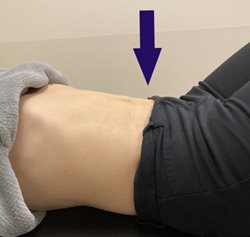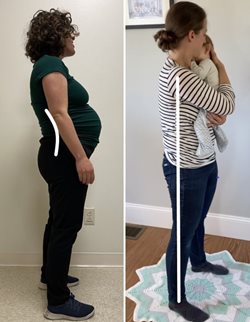Body Changes After Pregnancy
During pregnancy, the body undergoes many changes during three distinct prenatal trimesters. After delivery, the body recovers from these changes in three distinct postpartum trimesters. Generally, this process takes nine to twelve months, regardless of how your baby was delivered. The three main components of physical postpartum recovery are:
- Recovery of efficient breathing
- Recovery of normal core muscle function
- Restoring normal standing posture
During your recovery process, exercises designed to reestablish core strength — meaning your abdominal muscles, pelvic floor muscles and breathing mechanics — allow the body to restore efficient muscle control and minimize risk of chronic pain, bladder problems and/or bowel problems.
Exercises in the first 2 weeks postpartum
For the first two weeks after delivery, consider resting most of the time to let your body heal. When you feel ready, practice the following exercises to begin to restore core muscle control. Start with only 25-50 percent effort. Practice each exercise five to ten times in a row, in different positions: lying on your back, lying on your side, sitting in a chair, on hands and knees, kneeling… Discover what works best for you.
If any of these exercises are painful (more than 4-5 out of 10 on a pain scale and/or pain that does not improve with rest), you have increased bleeding, or something “doesn’t feel right”, stop! Try again more gently. If the problem keeps happening or gets worse, contact your obstetrician or midwife.
Diaphragmatic Breathing
The diaphragm attaches to the bottom of your ribcage. During pregnancy, the ribcage shifts to make space for the baby, and taking a deep breath is difficult. After delivery, breathing efficiently with the diaphragm allows your deep core muscles to contract efficiently and stabilize your torso, as well as calm your central nervous system and reduce stress.
EXERCISE STEPS: Breathe in through your nose, and allow the breath to drop into your belly. Imagine a beach ball in your belly: Take an easy breath in to fill the beach ball, so your belly and ribcage expand. Also allow that breath to drop into your pelvis, to relax your pelvic floor muscles. DO NOT move your skeleton or push down! The breath should feel relaxed. Leave your shoulders and neck relaxed.
Deep Abdominal Isolation
 The deepest layer of the abdominal muscles is called the transverse abdominus (TA). This muscle attaches at the bottom of the ribcage, the top of the pelvis (under your belt line), and extends around your torso attaching to the spine on both sides, stabilizing your torso. During pregnancy, the abdominal muscles stretch as the baby grows. After delivery, strengthening the TA supports your spine and pelvis while you lift and carry.
The deepest layer of the abdominal muscles is called the transverse abdominus (TA). This muscle attaches at the bottom of the ribcage, the top of the pelvis (under your belt line), and extends around your torso attaching to the spine on both sides, stabilizing your torso. During pregnancy, the abdominal muscles stretch as the baby grows. After delivery, strengthening the TA supports your spine and pelvis while you lift and carry.
EXERCISE STEPS: Breathe in and allow your belly to expand (just like you practice during diaphragmatic breathing). Breathe out, and gently pull in your lower belly like you are putting on your pre-maternity skinny jeans. Place both hands on your belly as you do this. Your lower belly should draw up and in toward your spine while your upper belly stays soft. Hold for a few seconds or until your breath is gone. If you had a cesarean, gently pull your incision in toward your spine.
Pelvic Floor Contraction and Relaxation
The pelvic floor muscles are located inside the bony pelvis, forming a muscular sling from the pubic bone to the sacrum. These muscles control bowel, bladder and sexual function, and also contract with the TA to stabilize the bottom of the torso. During pregnancy, these muscles work harder than normal to support the weight of the baby. If you pushed during delivery, or delivered vaginally, these muscles became overstretched. Regardless of how you delivered, these muscles need to heal from supporting your baby during pregnancy.
EXERCISE STEPS: Breathe in and allow your belly to expand (just like you practice during diaphragmatic breathing). Breathe out and gently tighten like you are holding in gas or a bowel movement (pulling the rectum up and in) or pulling a tampon into place. Hold for a few seconds or until your breath is gone.
Avoid holding your breath, clenching your abdominals (a different feeling then tightening your TA) or squeezing the muscles in your legs.
Core Muscle Activation
When you have mastered the three initial exercises (which may take four to six weeks!) teach your body how to engage your core muscles as a group again: breathe in, allowing your belly to expand and muscles to relax. Breathe out, Kegel, and tighten like you are putting on your skinny jeans. Hold for a few seconds or until your breath is gone.
If it’s easier, flip the order: breathe out, put on your skinny jeans, then Kegel. Practice whatever feels easier to you. When you can activate your core muscles without thinking about each step, practice this technique when you lift and carry.
Standing Posture
 During pregnancy, a person stands with a “swayback” posture — with an exaggerated curve in the low back especially — in order to balance the weight of the baby. After delivery, your body must learn to stand up straight again. This minimizes the risk of a back injury. To do this, stand sideways to a mirror:
During pregnancy, a person stands with a “swayback” posture — with an exaggerated curve in the low back especially — in order to balance the weight of the baby. After delivery, your body must learn to stand up straight again. This minimizes the risk of a back injury. To do this, stand sideways to a mirror:
- Pelvis: Place your hands on your hips, and imagine your pelvis is like a soup bowl: tip your pelvis forward, to pour some soup out the front, then backward, to pour some soup out the back. Go back and forth a few times, until you are standing with your pelvis balanced in the middle. Most people find they need to stand with their pelvis tipped back slightly.
- Ribcage: Now look at your rib cage. After delivery, many people stand with their rib cage behind their pelvis. Shift your rib cage forward so that your shoulder is oriented in line with your hip and your ankle.
If these exercises are difficult for you, ask for a referral to pelvic health physical therapy or enroll in a postpartum-specific core strengthening class. Master these exercises first before you progress to more advanced exercises in order to build strength efficiently and minimize risk of injury.
Postpartum Back Pain
Back pain after your baby is born can be common. While you are working on building back your core strength and standing posture, short term solutions for back pain include using a heating pad or cold pack (whichever feels better) for 15 to 20 minutes daily, asking your partner to massage sore muscles, gentle stretching, and moving around some throughout the day. Avoid sitting or lying down all day!
If back pain is not getting better four to six weeks after delivery, or is preventing you from caring for yourself or your baby, contact your OB/midwife and ask for a referral to physical therapy.
Helpful Posture Tips
- Avoid asymmetrical postures, such as sitting cross legged or standing on one leg with one hip jutting out (especially when carrying your baby).
- Avoid bending and twisting at the same time.
- Use good body mechanics: Bend from the knees and hips, not your back, especially when lifting your baby or older children.
Return to Exercise
Listen to your body! In general, we recommend waiting until your six-week postpartum appointment before resuming exercise other than walking and the exercises mentioned above. Some people may need more than six weeks before they are ready to resume physical activity; others may resume exercise sooner, especially if you are a person who has a lot of experience with core strengthening.
If you feel good enough to start exercising after your six-week postpartum visit, start slowly and gradually, as if you’ve never exercised before. If you have pain or discomfort, urinary/fecal incontinence, increased bleeding, or changes to your scar (if you have one), consider scaling back and consult with your OB/midwife if needed.
Things That Are “Not Normal” But Can Happen
If you experience any of these symptoms, consider consulting with your OB/midwife and ask for a referral to a pelvic health therapist:
- Urinary incontinence that is not significantly improved within six weeks after delivery
- Back or pelvic pain that is not significantly improved within a few weeks of delivery or interferes with daily activities
- Diastasis recti (separation of muscles down the center of your abdomen) that is not significantly improved within three to four months of delivery
- You develop pain, leaking, or feeling of something “falling out” when exercising or lifting
- You have fecal incontinence, constipation or urgency to have a bowel movement that you feel like you cannot control
- Something just doesn’t feel right. You know your body best. Trust yourself!
Booking an Appointment with a Pelvic Health Physical Therapist
If you are struggling with any of the above information, consider seeing a pelvic health therapist for individualized treatment. To book an appointment with a pelvic health physical therapist at the Clough Family Center for Rehabilitative and Sport Therapies in Concord or Westford ask your OB, midwife or your primary care physician for a referral to physical therapy. You can also contact our us at 978-287-8200.

